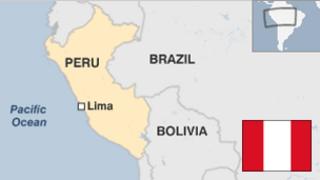Home » Latin America »
Peru country profile
Peru’s rich and varied heritage includes the ancient Incan capital of Cuzco and the lost city of Machu Picchu.
The country boasts spectacular scenery, including Lake Titicaca, the world’s highest navigable lake. A growing number of visitors are being drawn to its variety of attractions.
The country has been experiencing an economic boom. Foreign investors, attracted by the government and encouraged by favourable conditions, have been keen to get involved in exploiting the country’s mineral wealth, sometimes in the face of local resistance.
Peru has become the world’s leading producer of cocaine.
The country is still trying to come to terms with the trauma of a two-decade conflict – roughly from 1980 to 2000 – between the state and leftist guerrilla groups, the Tupac Amaru Revolutionary Movement and the Shining Path, which still has a following.
FACTS
Republic of Peru
Capital: Lima
Population 32 million
Area 1.28 million sq km (496,225 sq miles)
Major languages Spanish, Quechua, Aymara
Major religion Christianity
Life expectancy 72 years (men), 77 years (women)
Currency nuevo sol
LEADERS
President: Martín Vizcarra
Vice-President Vizcarra was sworn in as head of state in March 2018 after the resignation of Pedro Pablo Kuczynski amid allegations of corruption.
President Vizcarra is expected to serve out Mr Kuczynski’s term, which ends in 2021.
The new president said that tackling corruption will be a priority for his government, and has received the backing of the opposition Fujimoristas to investigate the allegations against his predecessor.
A former governor of mining-rich Moquegua Province, Mr Vizcarra is seen as business-friendly.
MEDIA
Privately-run broadcasters and newspapers dominate the media scene.
Lima is home to dozens of radio stations and several TV networks.
By 2017 some 18 million Peruvians were online – 56% of the population.
TIMELINE
Some key dates in Peru’s history:
1532-33 – Spanish conquistadores defeat the Incas, whose empire subsequently becomes part of the Vice-royalty of Peru with its capital in Lima.
1780 – Failed Inca revolt against Spanish led by Tupac Amaru II.
1824 – Peru is last colony in South America to gain independence from Spain.
1849-74 – Some 80,000-100,000 Chinese workers arrive in Peru to do menial jobs such as collecting guano.
1866 – Peruvian-Spanish war.
1879-83 – Peru and Bolivia are defeated by Chile during the Pacific War in which Peru loses territory to Chile.
1941 – Brief border war with Ecuador over disputed territory. The two countries clash again in 1981.
1948 – Military government installed following coup.
1963 – Peru returns to civilian rule, but in 1968 military takes over again. Gen Juan Velasco Alvarado introduces populist land reform programme and carries out large-scale nationalisations.
1980 – Return to civilian rule.
1980-2000 – Civil war involving Shining Path, or Sendero Luminoso, guerrillas seeking to overthrow the government. The conflict is estimated to claim 70,000 lives.
2000 – Congress sacks President Alberto Fujimori, who is later jailed for abuse of power and ordering death squad killings.
2011 onwards – Anti-mining protests.
Source: Read Full Article



